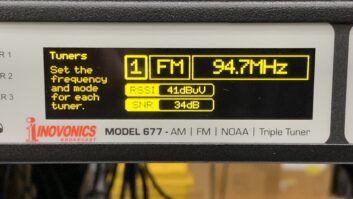When hiring broadcast engineers, there are two particulars to which we give special attention.
First and foremost is certifications. Little else says as much about a broadcast engineer�s dedication to their profession than having taken the time and effort to get certified.
Pin out for the Signetics �Write Only Memory� released in 1972. While the 25120 is no longer available, the author can, upon request, supply a schematic using discrete components that duplicates the WOM function.

The other trait is far subtler. Do they read manuals? Broadcast engineers from climates with long winters (or sans significant-other) tend to spend long evenings reading manuals. There is a lot of information in a manual � and way back when, there was fun and education in manuals.
It used to be that the design and manufacturing engineers, who often are surprisingly literate (most of the folks who write for this rag are broadcast engineers first), also did the drawings and wrote the text.
With time, increasing technical complexity and the need to specialize, manuals became disconnected and the province of non-engineers � professional writers operating under the tyranny of lawyers and marketers. Gone was the fun and too often the tutelage. Manuals have become a bad read � buried in boilerplate, lost in detail and too often devoid of meaning.
A manual is the ultimate sales tool. Before we buy a piece of gear, we at least thumb through the manual. If it�s good and helpful, it�s probably indicative of a good piece of gear. Nothing says �I don�t get it� like not having the manuals available on the web. Some idiot somewhere might be arguing that proprietary information is at risk if these are published. If the manual sucks, we run. If this gear gets into a station, it�s often a �corporate buy,� courtesy of the finance department that�s laser-focused on cheap.
A manual should be all about edification. It should be full of helpful hints, advice and ideas for utilizing and (dare we say) enjoying the product. It should give you a firm understanding of the physics and design objectives behind the piece. We should never have to reverse engineer it. We should admire the brilliance of the engineers and product managers behind this creation. We might not agree with the tradeoffs, but we expect to understand them and at least respect them.
The manual is a vendor�s tool to work around issues. If for any reason the thing doesn�t work like one expects, and innovative products often don�t, this is the manufacturer�s opportunity to avoid unpleasant surprises and cut down on service calls. Broadcast engineers have very sensitive BS meters and, by definition, are critical thinkers. We value straight talk above perfection. Cover ups don�t work.
Google might replace the consumer manual, but it shouldn�t replace the commercial manual.
And contrary to common conviction, broadcast engineers have a sense of humor. If you want to gain our trust and you are good at what you do, you are more than welcome to have a little fun now and then.
The 1954 Gates manual for a BC1-F clearly states that �if you install this transmitter and it doesn�t work, it�s almost certainly your fault�� We can respect that.
Manufacturers, if your lawyer has a problem with this, (metaphorically) shoot the lawyer. Just because they can�t change a light bulb, intentionally obfuscate with paragraphs of unintelligible legalese and insist on pages of boilerplate warnings about not operating your transmitter in pools of standing salt water (duh!), doesn�t mean they get to turn a manual into a boring, brain-dead blob, suitable only for temporarily insulating a shorted transformer from a chassis.
Please make manuals great again!











